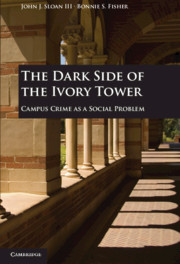Book contents
- Frontmatter
- Contents
- Preface
- Acknowledgments
- The Dark Side of The Ivory Tower
- Chapter One Violence, Vice, and Victimization on American College and University Campuses
- Chapter Two Constructing Campus Crime as a New Social Problem
- Chapter Three Constructing Unsafe and Violent College Campuses
- Chapter Four Constructing the Sexual Victimization of College Women on Campus
- Chapter Five Constructing Postsecondary Institutional Liability for Campus Crime
- Chapter Six Constructing Binge Drinking on College Campuses
- Chapter Seven The Legacy of Claimsmakers
- Index
- References
Chapter Two - Constructing Campus Crime as a New Social Problem
Published online by Cambridge University Press: 05 June 2012
- Frontmatter
- Contents
- Preface
- Acknowledgments
- The Dark Side of The Ivory Tower
- Chapter One Violence, Vice, and Victimization on American College and University Campuses
- Chapter Two Constructing Campus Crime as a New Social Problem
- Chapter Three Constructing Unsafe and Violent College Campuses
- Chapter Four Constructing the Sexual Victimization of College Women on Campus
- Chapter Five Constructing Postsecondary Institutional Liability for Campus Crime
- Chapter Six Constructing Binge Drinking on College Campuses
- Chapter Seven The Legacy of Claimsmakers
- Index
- References
Summary
On April 5, 1986, the whole Clery family fell victim to the medieval myth that college campuses that look safe are safe and the policy of a lot of college campuses, if it’s negative to their image, what you don’t know can’t hurt you.
Beginning in the late 1980s, mass-media sources were not the only ones focusing on the apparent emergence of a dark side of the ivory tower. Elected officials, government agencies, and academic researchers also began focusing their attention on it as well. In the late 1980s and early 1990s several states – including Pennsylvania, California, and Tennessee – passed “campus crime legislation” designed, among other goals, to ostensibly force postsecondary institutions to publish their crime statistics annually. In the 1990s Congress also passed federal campus crime legislation, which it then amended several times, including most recently in 2008. This legislation, originally known as the Student Right-to-Know and Campus Security Act of 1990, mandates all postsecondary institutions eligible to participate in federal financial aid programs to, among other requirements, compile an annual report on security policies and crime statistics for their campuses and make it available to the public, including prospective and current students and employees.
Additionally, throughout the 1990s a small but relatively prolific group of researchers from a range of disciplines began conducting social scientific studies into the extent and nature of crime on college campuses and published that work in both academic and popular press outlets. In the late 1990s the U.S. General Accounting Office expressed its concerns over “a steady rise in violent crime [being] reported on some college campuses,” while news outlets including the Chronicle of Higher Education and the New York Times frequently reported that “heinous crimes” were routinely occurring on (or near) college and university campuses in the United States.
- Type
- Chapter
- Information
- The Dark Side of the Ivory TowerCampus Crime as a Social Problem, pp. 29 - 51Publisher: Cambridge University PressPrint publication year: 2010



